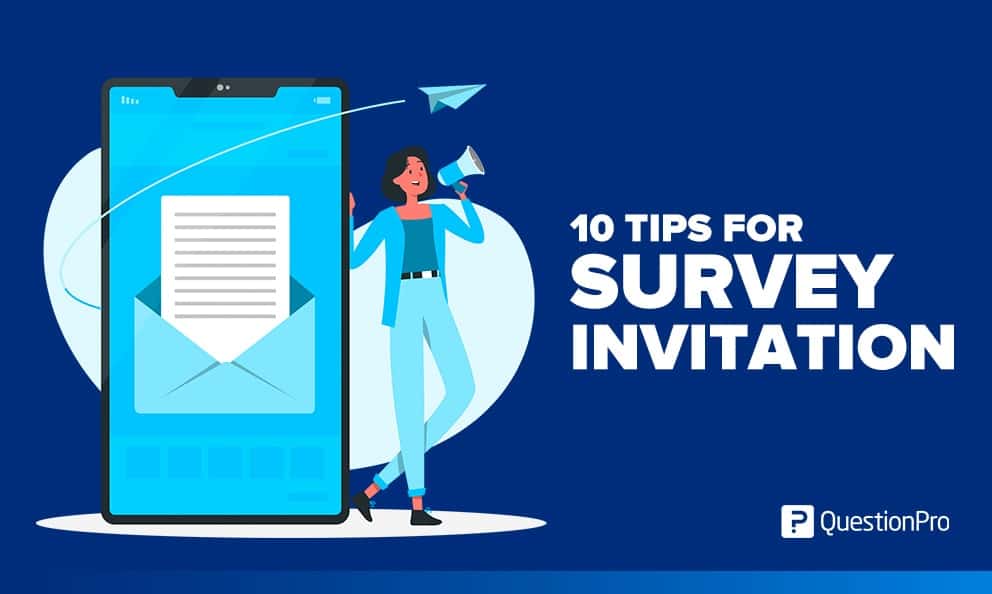 Reading Time: 4 minutes read
Reading Time: 4 minutes readOne of the most popular methods of data collection for researchers continues to be email due to its multiple benefits, including its personalization levels and its high response rate in surveys. For this reason, today we’ll bring you some tips to create a fantastic invitation for your email surveys.
Creating a great invitation for your surveys will guarantee that the people who receive your email participate in an honest way with their opinions. It is also a great opportunity to create a closer bond with your audience and be able to offer something in exchange for their valuable opinion.
Top Ten Tips for Writing a Survey Invitation
You’ve written your survey, and now it’s time to write the invitation to your potential respondents. But what should you say? Here are Top Ten Tips for Survey Invitation because no matter how spectacular your survey, a poorly worded invitation could keep people from even clicking the link to start taking your survey. Here are ten tips for writing your invitation.
- Personalize your invitation. Using the respondent’s name can catch their attention, as can any other information you might be able to include, such as company they work for, etc. Be sure that the information used for personalizing is pertinent to the survey, though, otherwise you run the risk of confusing the reader with extraneous information.And be sure that whatever information you use to personalize the invitation exists for all respondents, otherwise invitations might look odd if they are missing information.
- Tell them what the survey is about. Be straightforward in your invitation about the topic of your survey. People are less likely to click a link when they aren’t sure what to expect.
- Tell them how long the survey might take. Including the expected time the survey might require can help those with limited time to determine if they have time then or if they need to carve out some time later for the survey.Be sure to test how long it might take with a few people, too, rather than relying on estimates such as “5 questions per minute.” Depending on the topic of your survey, respondents might take more or less time thinking through their answers. Testing your survey with a select group of respondents can help you get a truer estimate of how long the survey might take.
- Include the timeline for the survey. Are you going to keep the survey open for a few days, a full week, two weeks, or even a month? Let your readers know. This can also help if you have a longer survey that they might want to set aside time for taking.
- If you are going to be collecting personally identifiable information (PII), let them know. Tell your respondents if you’re going to be collecting PII, and how you’re intending to use the information. Also be sure to let them know if entering their PII is optional or not as part of the survey.
- Include a link to your privacy policy. This helps instill trust for those who might be a bit nervous about taking a survey. In this era of people being concerned about their information being used for reasons other than those stated, offering a copy of your privacy policy in the invitation can stem the concerns by showing your accountability. It also adds that extra layer of knowing their responses will be kept confidential.
- Tell them how the information is going to be used. Is the survey data going to be used to inform future marketing campaigns, to determine how to improve a workplace, or in a report to a government department? Will they have future access to the report on the data? Let your respondents know.
- Keep it short and to the point. If your invitation is long, your audience might think your survey is also going to be long, regardless how long you said the survey might take them. If you have information that is making your invitation lengthy, you might consider putting extra information on a separate webpage and linking to it from the invitation.This could include frequently asked questions or a detailed version of how the data will be used.
- Keep the subject line short and catchy. Don’t make your invitation subject line long, else your respondents might get confused or lost trying to understand what the email is about. The best idea is to start with “Survey Invitation” or “Feedback Invitation” so that your audience knows exactly what to expect when they read the invitation itself.
- Be gracious. Thank them for their time. They’ve spent time reading your invitation, opening your email, when they could have ignored the invitation altogether. They are likely to spend time taking your survey. Be sure to be gracious in thanking them for the time they have already spent and the time they will likely spend taking your survey.You could even phrase it as thanks for helping achieve your goals, such as, “Thank you for helping us decide how to prioritize our store remodel,” or, “Thank you for helping us understand what we can do better as a company.”
If you have other tips that have worked for you when it comes to your survey invitations, leave us a comment and let us know!
Bonus: Use great email survey software
Crafting a good survey invitation will have a great impact on your research projects, however finding and using the best email survey software can make a big difference when conducting your research.
At QuestionPro we can provide you with all the tools you need to build the perfect survey, as well as specific functions for sending invitations.You’ll be able to upload contact lists, distribute your surveys, create custom invitations, use survey templates and be aware of the number of people who have responded to your survey.
Are you interested? Contact us or learn more to start collecting effective data.







